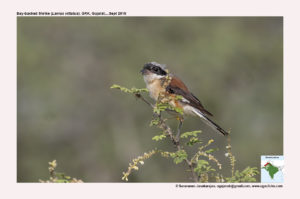Bay-backed Shrike

Bay-backed Shrike Lanius vittatus
Etymology :
- Lanius : Latin word for Butcher . They are known as ‘butcher-birds,’ from their habit of storing prey by impaling it on thorns and sharp twigs, giving the resemblance to a butcher’s slaughterhouse
- Vittatus : Latin word for “ banded” derived from vitta –ribbon, band
Vernacular Names: Baluchistan: Nargiani, Gunah, Sind: Boro, Hindi: Pachanak, ChotaLatora, Sans: Pascha-varnaklatushak, Pun: Chhotalatora, Ben: Chhotokilatora, Khayerikarkata,Guj: Pachnaklatoro, Mar: Gandharikhatik, UdiPathichaKhatik, Ta: Kichankuruvi, Te: Chinnabilinki, Vennedega, Mal: Asurakili
Distribution in India: Wide spread Resident in India except North East
Description: Size of 15-17 cm . It has black forehead and facial mask, pale grey crown and nape, dark grey upper mantle merging into chestnut-maroon mantle, back and scapulars; rump and upper tail-coverts greyish-white; upper wing black, conspicuous white primary patch, tail black, outermost pair of retrices mostly white; chin and throat whitish, underparts whitish with buff-brown to rufous-brown wash, flanks deeper rusty-coloured; iris dark brown; bill and legs black. Both sexes look alike.
Habitat: It is found in Variety of open, dry bushy areas with scattered trees, also cultivated areas and edge of more wooded areas. Preferred habitat intermediate between dry semi-desert and more wooded, watered areas
Food Habits: It eats insects, mainly beetles; lizards and occasionally mice and nestling birds. It forges solitary or in pairs; watches from exposed perch, preferably bush or electric wire, diving down to catch food on ground. Stores prey in caches.
Breeding Habits: They breed in Apr–Jul in NW, Feb–Sept in central and in Feb–Apr in south India.Lays two broods per year. They are Monogamous, and at all seasons highly territorial. The nest a quite small and neat cup, built from grass, feathers, wool and fibers, often with lichens on outside, lined with grass and other soft material above ground in fork or crotch of thorny bush or small tree. they lay a clutch 3–5 eggs, incubation is done by female, fed on or near nest by male. Incubation period is 14–15 days; male supplies most food, passes this to female and she feeds young, nestling period is 14–15 days.
.